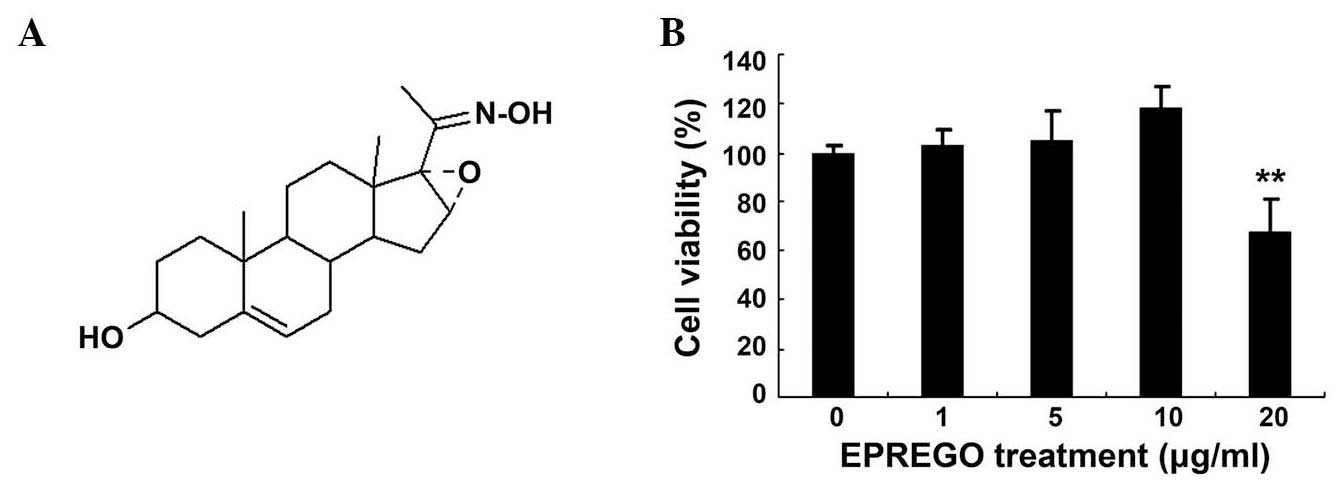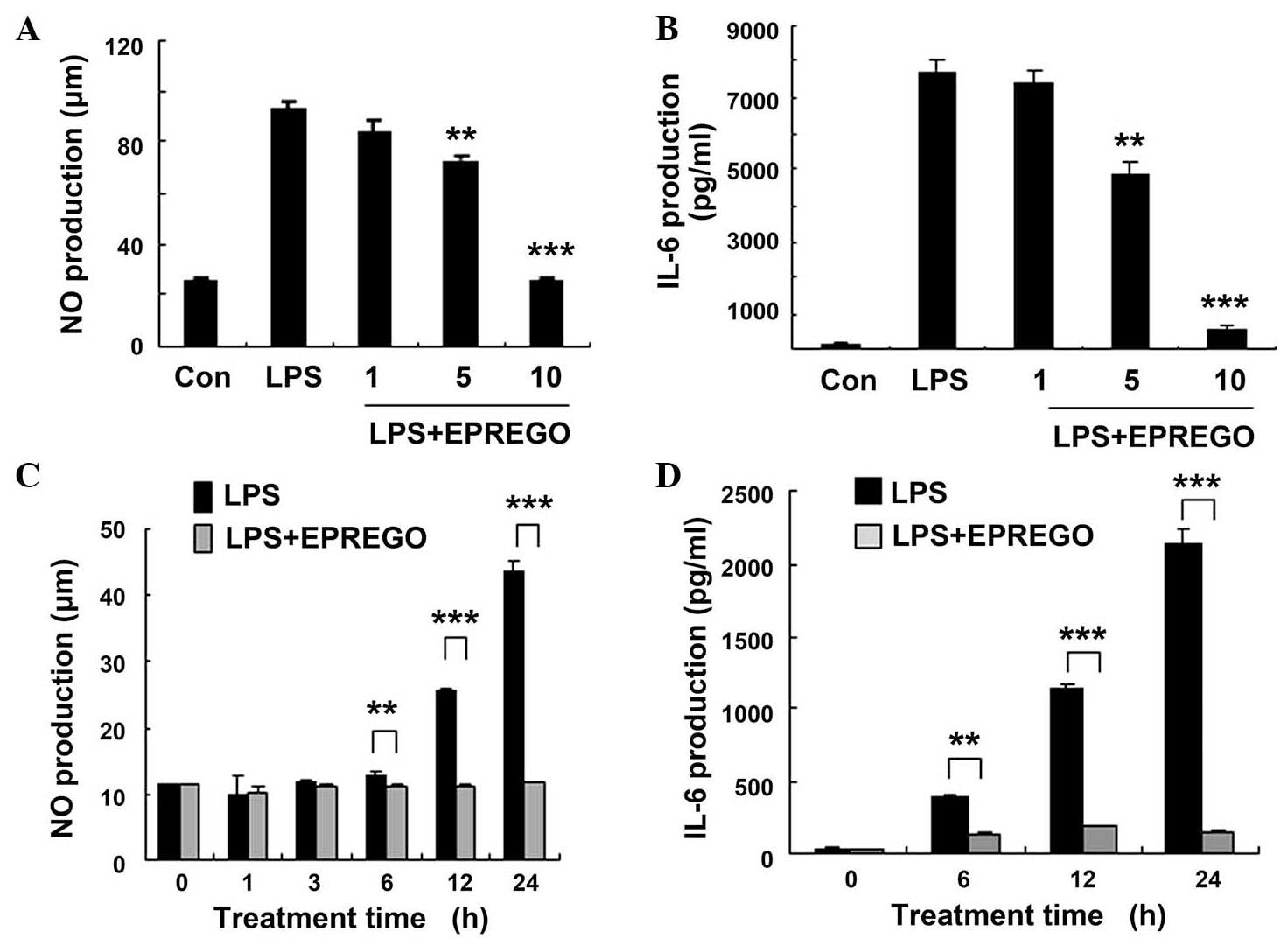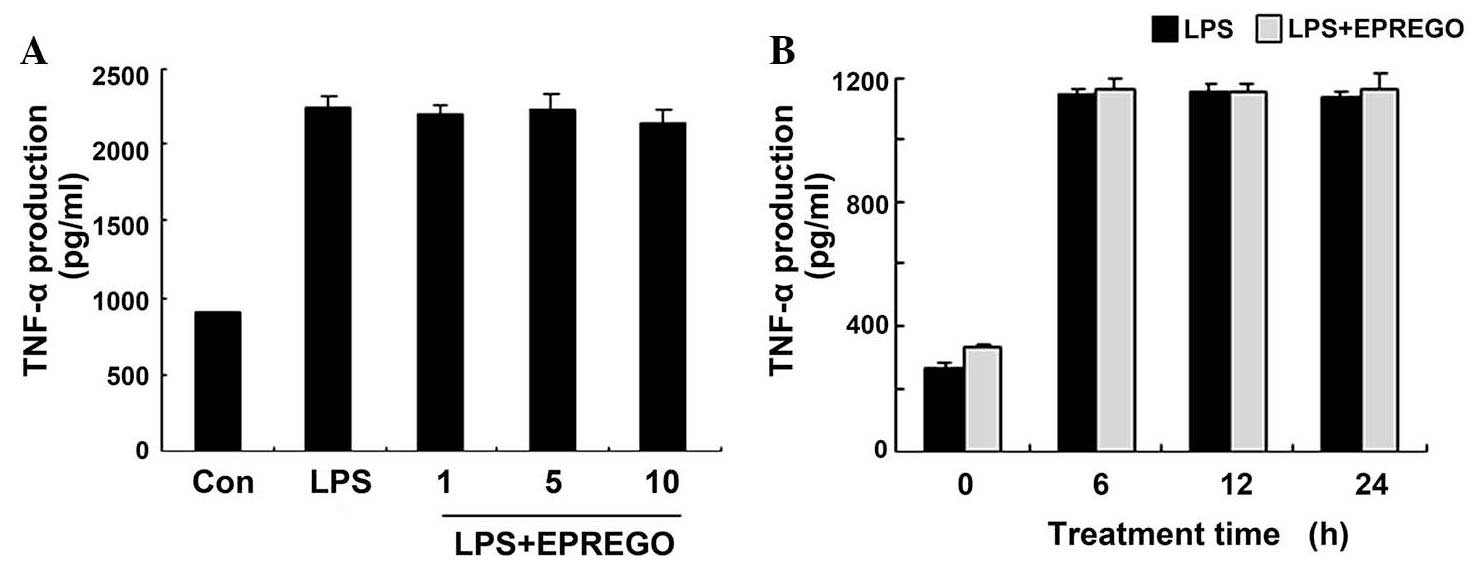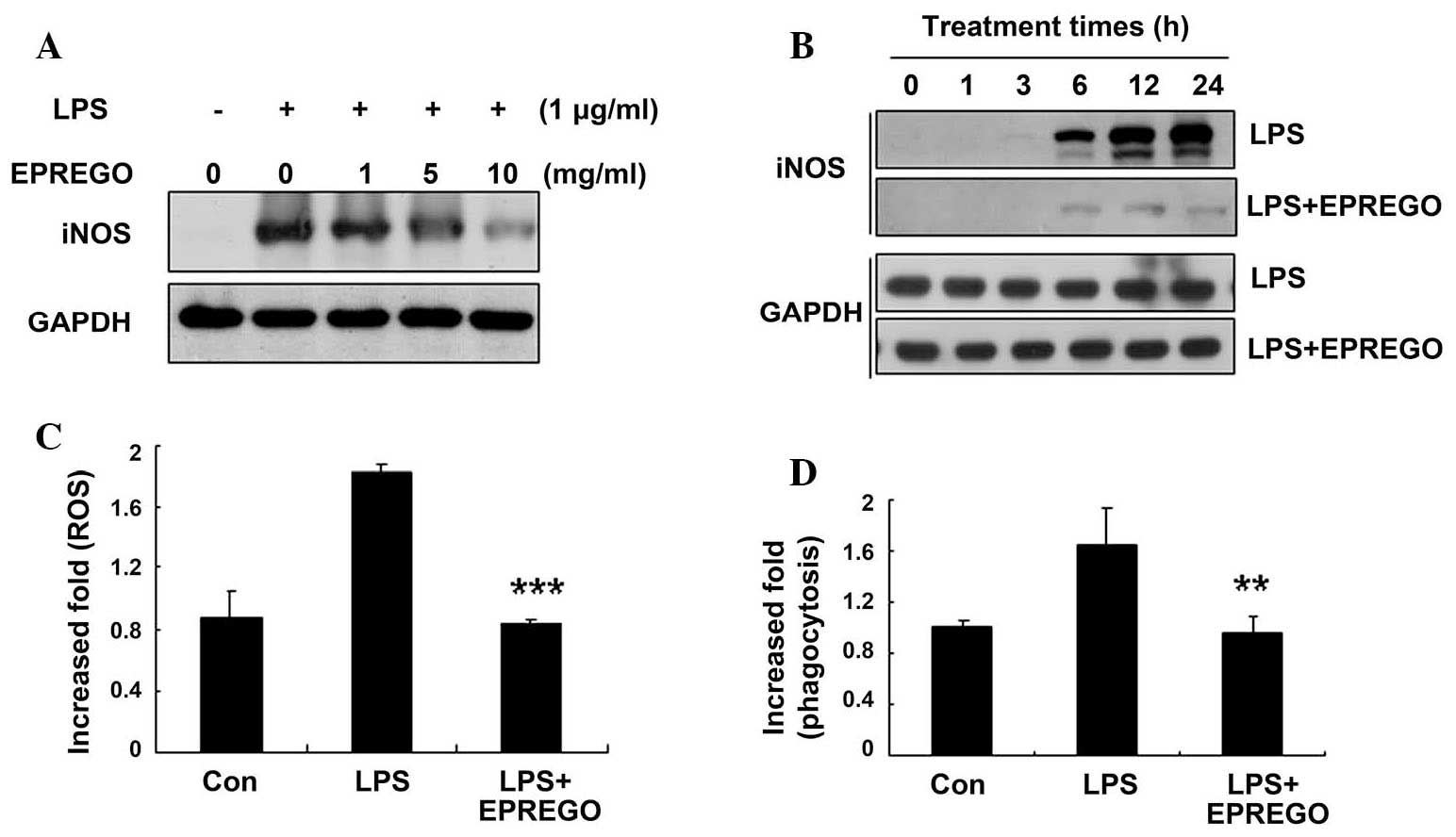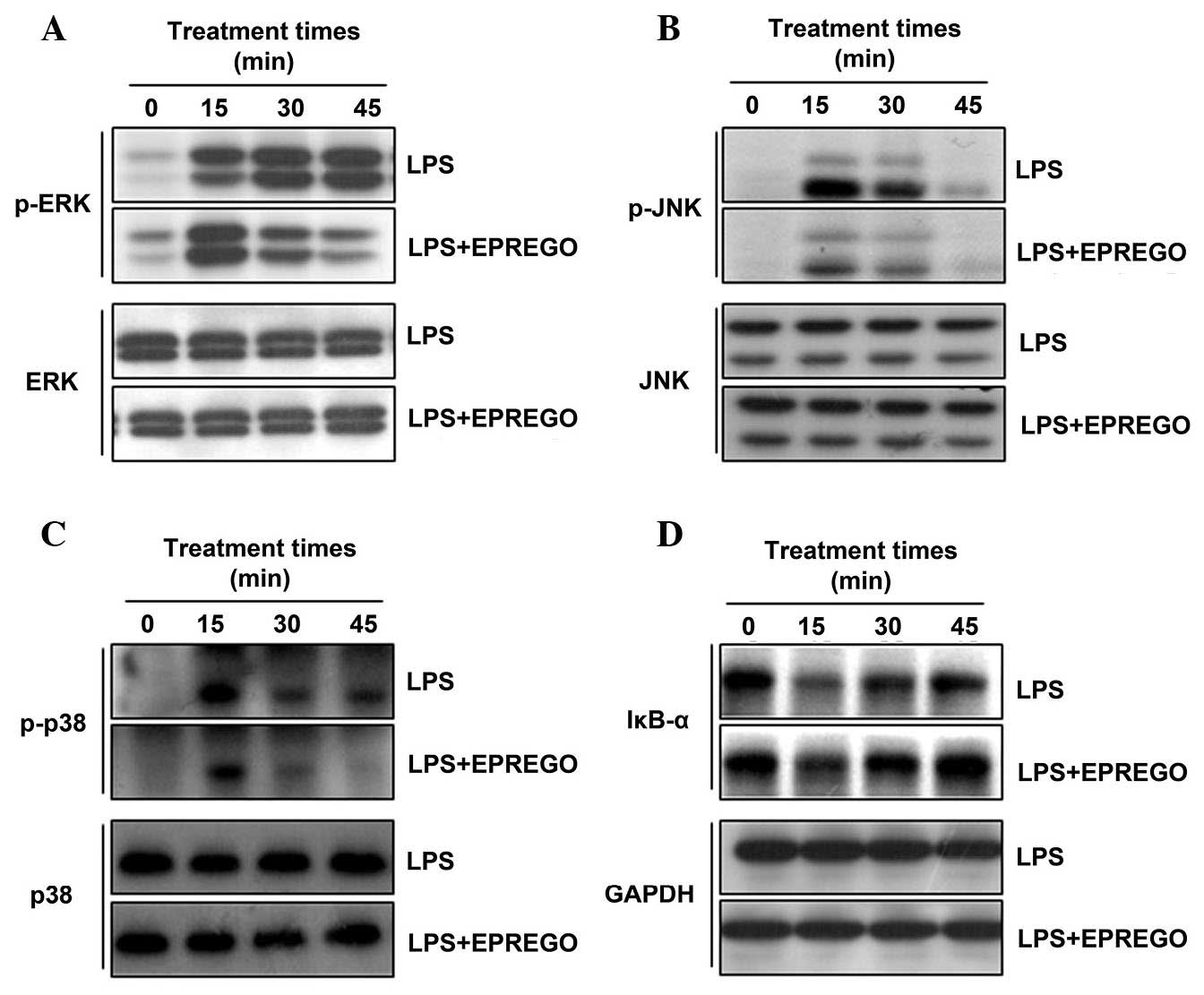16α, 17α-epoxypregnenolone-20-oxime inhibits NO and IL-6 production in LPS-treated RAW264.7 cells
- Authors:
- Published online on: April 14, 2016 https://doi.org/10.3892/mmr.2016.5125
- Pages: 4927-4933
Abstract
Introduction
Macrophages, which are critical effector cells, contribute to the innate immune response against infection. Macrophages are considered the most efficient pathogen scavengers, and are the main source of proinflammatory mediators and cytokines, including nitric oxide (NO), interleukin (IL)-6 and tumor necrosis factor (TNF)-α. Proinflammatory mediators are essential for inducing inflammation at the site of infection and for fighting pathogenic infections (1,2). However, the excessive production of proinflammatory cytokines has severe consequences, including tissue damage and septic shock (3,4). Therefore, suppressing the synthesis or release of proinflammatory cytokines and mediators is a potential therapeutic strategy for the treatment of septic shock-like diseases associated with inappropriately amplified inflammation.
Several intracellular signaling pathways, including the mitogen-activated protein kinase (MAPK) and nuclear factor-κB (NF-κB) pathways, are activated in lipopolysaccharide (LPS)-induced macrophages, and regulate inflammatory actions and immune responses. In macrophages, the MAPK signaling pathway is one of the most extensively investigated intracellular signaling cascades involved in the LPS-induced inflammatory response (5–8). The MAPK pathway is comprised of at least three signaling components: Extracellular signal-regulated kinases 1/2 (ERK 1/2); c-Jun N-terminal kinase (JNK); and p38 MAPK, all of which have been demonstrated to induce the release of immune-related cytotoxic factors and proinflammatory cytokines (9–11). Furthermore, NF-κB is important for controlling innate and adaptive immunity, and for regulating the expression of various genes during the inflammatory response (12). Activated NF-κB translocates into the nucleus of the cell and interacts with κB-binding sites in the promoter regions of target genes, in order to regulate the transcription of proinflammatory genes, including inducible nitric oxide synthase (iNOS), TNF-α and IL-6 (13,14).
LPS-stimulated NO production and iNOS expression have previously been reported to be inhibited by 16α, 17α-epoxypregnenolone-20-oxime (EPREGO) in BV2 microglial cells via downregulation of the JNK signaling pathway (15). These results indicated that EPREGO may be associated with neuroinflammation. EPREGO is an organic compound derived from 16-dehydropregnenolone-3-acetate (commonly known as 16-DPA); however, the mechanisms underlying the anti-inflammatory activity of EPREGO in macrophages remain unclear. The present study aimed to investigate the anti-inflammatory effects of EPREGO on LPS-stimulated macrophages.
Materials and methods
Chemicals
LPS (from Escherichia coli serotype 0111:B4) and inhibitors of p38 MAPK (SB203580), ERK (PD98059) and JNK (SP600125) were all purchased from Calbiochem (San Diego, CA, USA). EPREGO, a steroid oxime syntheses product derived from 16-dehydropregnenolone-3-acetate, was obtained as previously reported (15).
Cell culture
The RAW264.7 macrophages, immortalized mice macrophage cells (Shanghai BOGO Industrial Co., Ltd., Shanghai, China), was propagated in Dulbecco's modified Eagle's medium (DMEM; Gibco; Thermo Fisher Scientific, Inc., Waltham, MA, USA) supplemented with 10% fetal bovine serum (HyClone; GE Healthcare Life Sciences, Logan, UT, USA) and (100 U/ml penicillin-100 μg/ml streptomycin (HyClone, GE Healthcare Life Sciences). Exponentially growing RAW264.7 cells maintained in DMEM at 37°C and 5.0% CO2 were pretreated with 10 μg/ml EPREGO, followed by 1 μg/ml LPS for the indicated times (0, 1, 3, 6, 12 and 24 h).
Biochemical assay for the production of NO
NO production was assessed based on the accumulation of nitrite in the medium using a colorimetric reaction with Griess reagent. Culture supernatants were collected and mixed with an equal volume of Griess reagent [0.1% N-(1-naphthyl) ethyl-enediamine dihydrochloride, 0.1% sulfanilamide and 2.5% H3PO4]. Absorbance was measured at 540 nm using a UV MAX kinetic microplate reader (Molecular Devices, LLC, Sunnyvale, CA, USA).
Cell cytotoxicity analysis
RAW 264.7 cells were seeded into a 96-well dish (1.6×106 cells/ml) and exposed to 1, 5 or 10 μg/ml EPREGO without LPS for 24 h. A solution of 5 mg/ml 3-(4,5-dimethylthiazol-2-yl)-2,5-diphenyltetrazo-lium bromide (MTT; Sigma-Aldrich, St. Louis, MO, USA) was subsequently added to each well and the cells were incubated for 2 h at 37°C in an atmosphere containing 5% CO2. Subsequently, the supernatant was removed and formazan was solubilized with dimethyl sulfoxide. Absorbance was measured at 540 nm using a UV MAX kinetic microplate reader (Molecular Devices, LLC).
Western blotting
Protein lysates (30 μg) were extracted with protein lysis buffers (20 mM HEPES-OH, pH 7.0; 50 mM NaCl, 10% glycerol and 0.5% Triton X-100) and incubated with 0.5 μg/ml leupeptin; 0.7 μg/ml pepstatin A; 0.1 mM 4-(2-aminoethyl)-benzenesulfony fluoride and 2 μg/ml apro-tinin for 30 min at 4°C. The proteins were then denatured for 5 min and separated using 12% sodium dodecyl sulfate-poly-acrylamide gel electrophoresis and were transferred onto nitrocellulose membranes (EMD Millipore, Billerica, MA, USA). The membranes were blocked with 5% skimmed milk for 30 min, at room temperature. They were then incubated with polyclonal rabbit anti-iNOS (cat. no. 06-573, EMD Millipore, Billerica, MA, USA), polyclonal rabbit anti-IκB-α (cat. no. sc-371), mouse monoclonal anti-p-JNK (cat. no. sc-6254), anti-JNK (cat. no. sc-7345), mouse monoclonal anti-p-P38 (cat. no. sc-7973), mouse monoclonal anti-P38 (cat. no. sc-7972), mouse monoclonal anti-p-ERK (cat. no. sc-7383), and mouse monoclonal anti-ERK (cat. no. sc-514302) (all obtained from Santa Cruz Biotechnology, Inc., Dallas, TX, USA), and rabbit anti-glyceraldehyde 3-phosphate dehydrogenase (cat. no. PLA0125, Sigma-Aldrich) primary antibodies (dilution, 1:5,000) at 4°C overnight. The membranes were washed five times with Tris-buffered saline (TBS) containing Tween [10 mM Tris-HCl (pH 7.5), 150 mM NaCl and 0.2% Tween-20] and were subsequently incubated with horseradish peroxidase-conjugated goat anti-rabbit (cat. no. SAB3700878, 1:10,000) or anti-mouse immunoglobulin G (cat. no. SAB3701105, 1:10,000) (Sigma-Aldrich) for 1 h at room temperature. Following the removal of excess antibodies by washing with TBS, specific binding was detected using a chemiluminescence detection system (GE Healthcare Life Sciences, Chalfont, UK) according to the manufacturer's protocol.
Cytokine assays
The concentration of TNF-α and IL-6 in the cell culture supernatant was measured using enzyme-linked immunosorbent assay (ELISA) kits for TNF-α and IL-6 (eBioscience, Inc., San Diego, CA, USA). RAW264.7 cells (2.5×105 cells) were plated into a 48-well cell culture plate and incubated with various concentrations of EPREGO (1, 5 and 10 μg/ml) and 1 μg/ml LPS for 24 h. The culture supernatant was collected and assayed according to the manufacturer's protocols, in order to determine the concentration of TNF-α and IL-6 that had been released from the cells.
Measurement of phagocytosis and ROS by flow cytometry
Macrophage phagocytosis was analyzed with flow cytometry, according to a previously reported method (16). Briefly, Alexa 488-conjugated E. coli (Ec-A) BioParticles (Invit-rogen; Thermo Fisher Scientific, Inc.) were sonicated, added to the culture medium without serum at the final time of LPS treatment and incubated at 37°C for 15 min. Following incubation, the cells were washed with phosphate-buffered saline (PBS) three times and were resuspended in 500 μl PBS. The internalized fluorescence was immediately determined from 10,000 cells using a FACScan flow cytometer (BD Biosciences, Franklin Lakes, NJ, USA). To determine ROS levels, RAW264.7 cells were incubated with 10 mM CM-H2DCFDA (Invitrogen; Thermo Fisher Scientific, Inc.), a fluorescence-based ROS indicator, at 37°C for 15 min at the final time of various treatments, and the DCFDA fluorescence intensity from 10,000 cells was measured using FACScan (BD Biosciences). The results were analyzed using WinMDI (Version 2.9, BD Biosciences) software.
Statistical analysis
The data are presented as the mean ± standard error of the mean. Differences between experimental groups were analyzed by one-way analysis of variance and a Tukey test. GraphPad Prism software version 4.0 (GraphPad Software, Inc., La Jolla, CA, USA) was used to analyze results. P<0.01 was considered to indicate a statistically significant difference.
Results
EPREGO inhibits the production of proinflammatory cytokines in LPS-treated RAW264.7 cells
The chemical structure of EPREGO is presented in Fig. 1A. EPREGO is a steroid oxime that has previously been reported to exert an inhibitory effect on LPS-stimulated NO production in BV2 microglia cells (15). To examine the effects of EPREGO on macrophage cell viability, RAW264.7 cells were pretreated with various concentrations of EPREGO for 24 h, then stimulated with LPS for 12 h. Cell viability was detected using an MTT assay. As demonstrated in Fig. 1B, cell viability was not affected up to a concentration of 10 μg/ml, whereas, a higher concentration of EPREGO (20 μg/ml) significantly reduced the viability of RAW264.7 cells compared with untreated cells (P=0.008). Therefore, in subsequent studies 10 μg/ml was used as the highest treatment concentration. To evaluate whether EPREGO has anti-inflammatory properties, the NO, IL-6 and TNF-α levels in RAW264.7 cell culture supernatants were examined by ELISA following stimulation with LPS. Compared with LPS-stimulated cells, treatment with EPREGO dose- and time-dependently decreased the production of NO (P=0.009, P=0.0003 and P=0.0006 for 6, 12 and 24 h, respectively) and IL-6 (P=0.009, P=0.0003 and P=0.0006 for 6, 12 and 24 h, respectively) in LPS-treated RAW264.7 cells (Fig. 2), but did not markedly alter TNF-α secretion (Fig. 3). Furthermore, the results of western blotting experiments demonstrated that, compared with LPS stimulation, EPREGO inhibited iNOS (an enzyme involved in NO production) protein expression in a dose- and time-dependent manner (Fig. 4A and B), resulting in decreased NO production.
EPREGO decreases cellular ROS levels and macrophage phagocytosis in LPS-stimulated RAW264.7 cells
To investigate whether EPREGO affects the ROS levels and phagocytic capacity of LPS-stimulated macrophages, RAW264.7 cells were pretreated with EPREGO (10 μg/ml) for 30 min, followed by treatment with LPS (1 μg/ml) for 24 h. Cellular ROS levels and phagocytosis were examined using flow cytometry. LPS increased cellular ROS levels, which were significantly decreased by treatment with EPREGO, almost to basal levels compared with LPS-treated cells (Fig. 4C, P=0.00011). Similarly, treatment with EPREGO significantly decreased phagocytosis compared with LPS-stimulated RAW264.7 cells (Fig. 4D, P=0.008). Together these results (Figs. 2Figure 3–4) demonstrate that EPREGO may exert anti-inflammatory effects in RAW264.7 cells.
EPREGO exhibits anti-inflammatory effects by inhibiting MAPK signaling pathways
The MAPK and NF-κB signaling pathways are crucial mediators of proinflammatory cytokine production in macrophages (9–12). To determine the mechanism underlying the anti-inflammatory activities of EPREGO in RAW264.7 cells, the MAPK pathways were investigated by detecting the phosphorylation levels of ERK, JNK and p38. RAW264.7 cells were pretreated with EPREGO (10 μg/ml) for 30 min, followed by treatment with LPS (1 μg/ml) for the indicated times, and MAPK phosphorylation was subsequently examined using western blotting. The results demonstrated that treatment with LPS upregulated ERK, p38 and JNK phosphorylation compared with in the untreated cells, whereas phosphorylation was markedly downregulated by EPREGO treatment compared with LPS-treated cells (Fig. 5A–C). Furthermore, the inhibitory effect of EPREGO on the NF-κB signaling pathway was investigated by examining IκBα degradation. IκBα degradation in RAW264.7 cells was markedly inhibited by EPREGO treatment compared with LPS-stimulated cells (Fig. 5D). To determine whether the MAPK signaling pathways were associated with the anti-inflammatory effects of EPREGO on LPS-stimulated macrophage inflammation, the effects of pharmaceutical MAPK inhibitors were assessed. The results demonstrated that treatment with SB203580 (p38 inhibitor), PD98059 (ERK inhibitor) and SP600125 (JNK inhibitor), as well as EPREGO, significantly decreased NO (P=0.008, P=0.0003, P=0.004 and P=0.0002 for SB203580, PD98059, SP600125 and EPREGO, respectively) and IL-6 (P=0.0003, P=0.0007, P=0.0002 and P=0.0003 for SB203580, PD98059, SP600125 and EPREGO, respectively) production in RAW264.7 cells compared with LPS treatment (Fig. 6A and B), whereas TNF-α secretion was not markedly altered (Fig. 6C). These results indicate that MAPK signaling pathways are associated with the inhibitory effects of EPREGO on NO and IL-6 production in LPS-treated RAW264.7 cells.
Discussion
Inflammation is the host response to infection and injury; however, if uncontrolled, inflammatory mediators become involved in the pathogenesis of various inflammatory disorders (17). Proinflammatory cytokines that are typically released by macrophages are critical for initiating and sustaining the inflammatory response.
Following processing, 16-dehydropregnenolone-3-acetate, a major intermediary for hormone- and steroid-associated drugs (18,19), exhibits anti-inflammatory, anti-toxin, anti-shock and anti-allergenic effects. EPREGO, which is derived from 16-dehydropregnenolone-3-acetate, was previously reported to inhibit NO production in LPS-stimulated BV2 microglia cells (15); however, to the best of our knowledge, its potential anti-inflammatory properties have not been investigated in macrophages. The present study investigated the effects of EPREGO on proinflammatory cytokine production in LPS-stimulated RAW264.7 macrophages. Treatment with EPREGO significantly decreased LPS-stimulated NO and IL-6 production (Fig. 2), and iNOS protein expression, but did not alter TNF-α production (Fig. 3) in RAW264.7 cells. Furthermore, EPREGO reduced the LPS-induced cellular ROS levels and phagocytosis of RAW264.7 cells (Fig. 4). These observations are consistent with previous reports (15), indicating that EPREGO exerts anti-inflammatory activity in RAW264.7 cells.
Mechanistic analysis within the present study demonstrated that EPREGO may significantly downregulate LPS-stimulated phosphorylation of ERK, JNK and p38 (Fig. 5A–C), thus indicating that the inhibitory activity of EPREGO on the production of NO and IL-6 in RAW264.7 cells is associated with the MAPK signaling pathway. Upon LPS recognition of complex proteins, including LPS binding protein, cluster of differentiation 14, lymphocyte antigen 96 and Toll-like receptor (TLR) 4, a series of TLR-mediated signal pathways activate downstream IκB kinase (IKK) and MAPK pathways (20). The NF-κB and MAPK pathways are the major intracellular signaling pathways activated by LPS binding to TLR4 on the cell membrane (5,21). MAPKs are a family of serine/threonine protein kinases responsible for most cellular responses to cytokines, which are crucial for regulating the production of inflammatory mediators (22–25). As previously reported, EPREGO inhibits NO production and iNOS expression by selectively downregulating JNK phosphorylation (15). The present study demonstrated that treatment with EPREGO inhibits the phosphorylation of JNK, ERK and p38 in RAW264.7 cells (Fig. 5A–C). The differential effects of EPREGO on MAPK (ERK, JNK and p38) signaling pathways between microglia and macrophages may be due to the different characteristics of the two cell types, and the mechanism for this regulation should be investigated further. In addition, treatment of RAW264.7 cells with pharmaceutical inhibitors for ERK (PD98059), JNK (SP600125) and p38 (SB203580) inhibited the production of NO and IL-6 (Fig. 6A and B). These results suggested that EPREGO may alter the MAPK signaling cascade, resulting in decreased NO and IL-6 production.
NF-κB is a major transcription factor that regulates the expression of genes responsible for the innate and adaptive immune responses. The inappropriate regulation of NF-κB has been associated with cancer, and inflammatory and autoimmune diseases. NF-κB has been demonstrated to be important for the inflammatory response and the expression of inflammatory cytokines, including NO, TNF-α and IL-6. NF-κB activation is induced by the dissociation of IκBα/β, which are phosphorylated by IKK. The level of IκBα and IκBβ degradation is commonly used as an indicator of NF-κB activation (26). In the present study, EPREGO was demonstrated to inhibit IκBα degradation in LPS-stimulated RAW264.7 cells (Fig. 4D), which indicated that EPREGO potentially suppresses the NF-κB signaling pathway, thus, reducing inflammatory response-mediated NO and IL-6 production. These results are consistent with previous reports demonstrating that the NF-κB signaling pathway is essential for LPS-stimulated cytokine production (27–30) in macrophages.
In the present study, although EPREGO inhibited IκBα degradation and the phosphorylation of MAPKs (Fig. 5), it had no effect on TNF-α production (Fig. 3), thus suggesting that LPS-induced TNF-α secretion is influenced by other signaling pathways. Indeed, it was previously reported that the Janus kinase (JAK)/signal transducer and activator of transcription (STAT) signaling pathway is involved in proinflammatory cytokine and ROS production (31–33); therefore, it is hypothesized that TNF-α production may be regulated by the JAK/STAT signaling pathway, and an analysis of the inhibitory effect of EPREGO on LPS-stimulated JAK/STAT signaling is currently being investigated.
In conclusion, the results of the present study indicated that EPREGO attenuates the production of NO and IL-6 in LPS-stimulated RAW264.7 cells, and decreases cellular ROS levels and phagocytosis by inhibiting the MAPKs and NF-κB signaling pathways. The results suggest that EPREGO exhibits an anti-inflammatory role in macrophage cells, and may serve as a therapeutic agent for macrophage-mediated inflammation.
Acknowledgments
The present study was supported by the Scientific Research Foundation of the Heilongjiang Provincial Education Department of China (no. 1251H010) and the Ministry of Education Scientific Research Foundation for Returned Overseas Students (46th).
Abbreviations:
|
LPS |
lipopolysaccharide |
|
NO |
nitric oxide |
|
iNOS |
inducible nitric oxide synthase |
|
TNF-α |
tumor necrosis factor-α |
|
IL-6 |
interleukin-6 |
|
NADPH |
nicotinamide adenine dinucleotide phosphate |
|
EPREGO |
16α, 17α-epoxypregnenolone-20-oxime |
References
|
Underhill DM and Ozinsky A: Phagocytosis of microbes: Complexity in action. Annu Rev Immunol. 20:825–852. 2002. View Article : Google Scholar : PubMed/NCBI | |
|
Li W, Ashok M, Li J, Yang H, Sama AE and Wang H: A major ingredient of green tea rescues mice from lethal sepsis partly by inhibiting HMGB1. PLoS One. 2:e11532007. View Article : Google Scholar : PubMed/NCBI | |
|
Takeuchi O and Akira S: Pattern recognition receptors and inflammation. Cell. 140:805–820. 2010. View Article : Google Scholar : PubMed/NCBI | |
|
Cohen J: The immunopathogenesis of sepsis. Nature. 420:885–891. 2002. View Article : Google Scholar : PubMed/NCBI | |
|
Guha M and Mackman N: LPS induction of gene expression in human monocytes. Cell Signal. 13:85–94. 2001. View Article : Google Scholar : PubMed/NCBI | |
|
Ehlting C, Ronkina N, Böhmer O, Albrecht U, Bode KA, Lang KS, Kotlyarov A, Radzioch D, Gaestel M, Häussinger D and Bode JG: Distinct functions of the mitogen-activated protein kinase-activated protein (MAPKAP) kinases MK2 and MK3: MK2 mediates lipopolysaccharide-induced signal transducers and activators of transcription 3 (STAT3) activation by preventing negative regulatory effects of MK3. J Biol Chem. 286:24113–24124. 2011. View Article : Google Scholar : PubMed/NCBI | |
|
Hsieh TP, Sheu SY, Sun JS and Chen MH: Icariin inhibits osteoclast differentiation and bone resorption by suppression of MAPKs/NF-κB regulated HIF-1α and PGE(2) synthesis. Phytomedicine. 18:176–185. 2011. View Article : Google Scholar | |
|
Shin JS, Noh YS, Lee YS, Cho YW, Baek NI, Choi MS, Jeong TS, Kang E, Chung HG and Lee KT: Arvelexin from Brassica rapa suppresses NF-κB-regulated pro-inflammatory gene expression by inhibiting activation of IκB kinase. Br J Pharmacol. 164:145–158. 2011. View Article : Google Scholar : PubMed/NCBI | |
|
Kim JH, Kim DH, Baek SH, Lee HJ, Kim MR, Kwon HJ and Lee CH: Rengyolone inhibits inducible nitric oxide synthase expression and nitric oxide production by down-regulation of NF-kappaB and p38 MAP kinase activity in LPS-stimulated RAW 264.7 cells. Biochem Pharmacol. 71:1198–1205. 2006. View Article : Google Scholar : PubMed/NCBI | |
|
Al-Mutairi MS, Cadalbert LC, McGachy HA, Shweash M, Schroeder J, Kurnik M, Sloss CM, Bryant CE, Alexander J and Plevin R: MAP kinase phosphatase-2 plays a critical role in response to infection by Leishmania mexicana. PLoS Pathog. 6:e10011922010. View Article : Google Scholar : PubMed/NCBI | |
|
Liu HE, Chang AS, Teng CM, Chen CC, Tsai AC and Yang CR: Potent anti-inflammatory effects of denbinobin mediated by dual inhibition of expression of inducible no synthase and cyclooxygenase 2. Shock. 35:191–197. 2011. View Article : Google Scholar | |
|
Liou HC: Regulation of the immune system by NF-kappaB and IkappaB. J Biochem Mol Biol. 35:537–546. 2002. View Article : Google Scholar : PubMed/NCBI | |
|
Karin M and Delhase M: The I kappaB kinase (IKK) and NF-kappa B: Key elements of proinflammatory signalling. Semin Immunol. 12:85–98. 2000. View Article : Google Scholar : PubMed/NCBI | |
|
Baeuerle PA and Baltimore D: NF-kappaB: Ten years after. Cell. 87:13–20. 1996. View Article : Google Scholar : PubMed/NCBI | |
|
Sun HN, Jin MH, Han B, Feng L, Han YH, Shen GN, Yu YZ, Jin CH, Lian ZX, Lee DS, et al: 16α, 17α-Epoxypregnenolone-20-oxime prevent LPS-induced NO production and iNOS expression in BV-2 microglial cells by inhibiting JNK phosphorylation. Biol Pharm Bull. 37:1096–1102. 2014. View Article : Google Scholar | |
|
Liu Y, Hao W, Letiembre M, Walter S, Kulanga M, Neumann H and Fassbender K: Suppression of microglial inflammatory activity by myelin phagocytosis: Role of p47-PHOX-mediated generation of reactive oxygen species. J Neurosci. 26:12904–12913. 2006. View Article : Google Scholar : PubMed/NCBI | |
|
Ritchlin CT, Haas-Smith SA, Li P, Hicks DG and Schwarz EM: Mechanisms of TNF-alpha- and RANKL-mediated osteoclastogenesis and bone resorption in psoriatic arthritis. J Clin Invest. 111:821–831. 2003. View Article : Google Scholar : PubMed/NCBI | |
|
Chowdhury P, Das AM and Goswami P: Synthesis of some new steroidal [16alpha, 17alpha-d]-isoxazolines. Steroids. 70:494–498. 2005. View Article : Google Scholar : PubMed/NCBI | |
|
Banerjee T, Shukla A, Shinde K and Patil S: Mixed culture bioconversion of 16-dehydropregnenolone acetate to androsta-1,4-diene-3,17-dione: Optimization of parameters. Biotechnol Prog. 19:662–664. 2003. View Article : Google Scholar : PubMed/NCBI | |
|
Lu YC, Yeh WC and Ohashi PS: LPS/TLR4 signal transduction pathway. Cytokine. 42:145–151. 2008. View Article : Google Scholar : PubMed/NCBI | |
|
Pålsson-McDermott EM and O'Neill LA: Signal transduction by the lipopolysaccharide receptor, Toll-like receptor-4. Immunology. 113:153–162. 2004. View Article : Google Scholar : PubMed/NCBI | |
|
Cao W, Bao C, Padalko E and Lowenstein CJ: Acetylation of mitogen-activated protein kinase phosphatase-1 inhibits Toll-like receptor signaling. J Exp Med. 205:1491–1503. 2008. View Article : Google Scholar : PubMed/NCBI | |
|
Cheng YW, Chang CY, Lin KL, Hu CM, Lin CH and Kang JJ: Shikonin derivatives inhibited LPS-induced NOS in RAW 264.7 cells via downregulation of MAPK/NF-kappaB signaling. J Ethnopharmacol. 120:264–271. 2008. View Article : Google Scholar : PubMed/NCBI | |
|
Xie C, Kang J, Ferguson ME, Nagarajan S, Badger TM and Wu X: Blueberries reduce pro-inflammatory cytokine TNF-α and IL-6 production in mouse macrophages by inhibiting NF-κB activation and the MAPK pathway. Mol Nutr Food Res. 55:1587–1591. 2011. View Article : Google Scholar : PubMed/NCBI | |
|
Chu X, Ci X, He J, Wei M, Yang X, Cao Q, Li H, Guan S, Deng Y, Pang D and Deng X: A novel anti-inflammatory role for ginkgolide B in asthma via inhibition of the ERK/MAPK signaling pathway. Molecules. 16:7634–7648. 2011. View Article : Google Scholar : PubMed/NCBI | |
|
Kim HG, Kim NR, Gim MG, Lee JM, Lee SY, Ko MY, Kim JY, Han SH and Chung DK: Lipoteichoic acid isolated from Lactobacillus plantarum inhibits lipopolysaccharide-induced TNF-alpha production in THP-1 cells and endotoxin shock in mice. J Immunol. 180:2553–2561. 2008. View Article : Google Scholar : PubMed/NCBI | |
|
Jin S, Park JY, Hong JM, Kim TH, Shin HI, Park EK and Kim SY: Inhibitory effect of (−)-epigallocatechin gallate on titanium particle-induced TNF-α release and in vivo osteolysis. Exp Mol Med. 43:411–418. 2011. View Article : Google Scholar : PubMed/NCBI | |
|
Li M, Zhong X, He Z, Wen M, Li J, Peng X, Liu G, Deng J, Zhang J and Bai J: Effect of erythromycin on cigarette-induced histone deacetylase protein expression and nuclear factor-κB activity in human macrophages in vitro. Int Immunopharmacol. 12:643–650. 2012. View Article : Google Scholar : PubMed/NCBI | |
|
Li YQ, Zhang ZX, Xu YJ, Ni W, Chen SX, Yang Z and Ma D: N-Acetyl-L-cysteine and pyrrolidine dithiocarbamate inhibited nuclear factor-kappaB activation in alveolar macrophages by different mechanisms. Acta Pharmacol Sin. 27:339–346. 2006. View Article : Google Scholar : PubMed/NCBI | |
|
Korobowicz A: Biology of tumor necrosis factor type alpha (TNF-alpha). Pol Merkur Lekarski. 21:358–361. 2006.In Polish. | |
|
Shuai K and Liu B: Regulation of JAK-STAT signalling in the immune system. Nat Rev Immunol. 3:900–911. 2003. View Article : Google Scholar : PubMed/NCBI | |
|
Ohmori Y and Hamilton TA: Requirement for STAT1 in LPS-induced gene expression in macrophages. J Leukoc Biol. 69:598–604. 2001.PubMed/NCBI | |
|
Simon AR, Rai U, Fanburg BL and Cochran BH: Activation of the JAK-STAT pathway by reactive oxygen species. Am J Physiol. 275:C1640–C1652. 1998.PubMed/NCBI |



